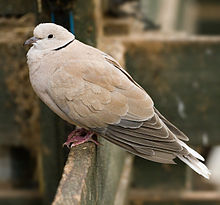Barbary dove
| Barbary dove | |
|---|---|
 |
|
|
Domesticated
|
|
| Scientific classification (disputed) | |
| Kingdom: | Animalia |
| Phylum: | Chordata |
| Class: | Aves |
| Order: | Columbiformes |
| Family: | Columbidae |
| Genus: | Streptopelia |
| Species: | S. risoria |
| Binomial name | |
|
Streptopelia risoria (Linnaeus, 1758) |
|
The Barbary dove, ringed turtle dove, ringneck dove, ring-necked turtle dove, or ring dove (Streptopelia risoria) is a domestic member of the dove family (Columbidae).
Although the Barbary dove is normally assigned its own systematic name, as Streptopelia risoria, considerable doubt exists as to its appropriate classification. Some sources confidently assert that it is a domestic form of the Eurasian collared dove, S. decaocto, but the majority of evidence points to it being a domesticated form of the African collared dove, S. roseogrisea. It appears that it can hybridise freely with either species, and its status as a species must therefore be regarded as doubtful. However, because of the wide use of both the common and systematic names, it is best to consider it separately from either of the putative parent species. Their time of domestication is also uncertain. While Linnaeus described them in 1756, they may have been imported into Italy from North Africa in the late 16th century.
Barbary doves are easily kept, and long-lived, in captivity, living for up to 12 years. However, There have been cases of doves living over 20 years, and at one point a dove living up to 29 years In recent years they have been used extensively in biological research, particularly into the hormonal bases of reproductive behaviour, because their sequences of courtship, mating and parental behaviour have been accurately described and are highly consistent in form. Dove fanciers have bred them in a great variety of colours; the number of colours available has increased dramatically in the latter half of the twentieth century, and it is thought that this has been achieved by interbreeding with S. roseogrisea. Some of these doves carry a mutation that makes them completely white. These white Barbaries are most commonly used in stage magic acts. White Barbary doves are traditionally released in large public ceremonies, since it is a peace symbol in several cultures, and "dove releases" are also sometimes found at weddings and funerals. However, a release dove is, in fact, usually a homing pigeon, as Barbary doves lack the homing instinct and will die left out in the wild.
...
Wikipedia
